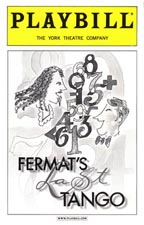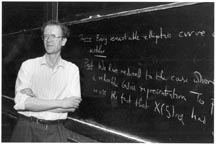|
Web
Exclusives:Features
How do you make a musical about a bunch of dead mathematicians and one very alive, very famous, Princeton math professor? Andrew Wiles, the Eugene Higgins professor of math, gained worldwide fame for his 1993 solution to Fermat's last theorem, which dates to 1637. The theorem states that for the equation xn+yn=zn there are no positive whole numbers that solve this when "n" is greater than 2.
Jump three hundred years to the 1980s and '90s: Wiles worked on proving the theorem exclusively and secretly for seven years, and startled the world of mathematics by publishing his proof, which was accepted, after a modification, in 1995. Which leads us back to the original question: How do you make a musical about math? In the musical The Sound of Music, the nuns grappled with the troublesome novice Maria - who talks and sings too much - and in exasperation sang a song whose first line was "How do you solve a problem like Maria? Would a mathematical musical follow the same idea? "How do solve a problem like Fermat's? Why do you know a proof and not jot it down? How do you sing about the dead guy Fermat? A mathematician! An illusive Frenchman. A clown?" Or "How do you write a musical about math? When do you sing and when do you dance around? What can you say about the men of math, Who're bright, but very dead and not around?" Those are the kinds of silly lyrics that came to mind when news of a musical based on Andrew Wiles and Pierre de Fermat was published last year. Happily, composer Joshua Rosenblum and his lyricist, Joanne Sydney Lessner (who is also his wife), grappled with the problem and solved it magnificently, with a story and song much more inspired than the verses penned above (which they did not write). The show, Fermat's Last Tango, now on stage at the York Theatre Company in New York City brings to vivid life not only Pierre de Fermat (outfitted in courtly clothes and gold-and-red shoes), Andrew Wiles (portrayed as Daniel Keane in corduroy pants, tweedy jacket, and horn-rimmed glasses), but also the mathematicians Pythagoras, Euclid (who throughout the show measures the angles her own body makes), Sir Isaac Newton, and Carl Friedrich Gauss. Many of the songs are funny, and one of the most brilliant bits of invention is the place the mathematicians go after death: the Aftermath. Andrew Wiles and his wife, Nada Canaan Wiles '83 *88, took their children to see the show in December, and PAW asked him how he liked it. Below is his response. I went with my whole family, and yes, we really liked the show. My six-year-old was quite captivated by Fermat (or Theorem as she called him) and kept trying to tell me something during the performance. I couldn't hear what she was saying but afterwards she told me that she had wanted to tell me that he was lying and that he didn't have a proof! I had not communicated with the composers so the first I knew about it being on was when some local publications (including the Prince) started calling to ask me about it. I thought that a musical on such a theme would be impossible but we all thought it was very cleverly done. I think that putting Fermat in the role of tormentor was very inspired and really was the key to the success of the show - both as he personified the struggle that research in mathematics involves and also as he gave vent to some of the all too human characteristics of real life personalities in math. I think that it did especially capture the feeling that one sometimes has when one is doing mathematics that obstacles have been put there deliberately to taunt you, but also the feeling of wonder at the beauty and simplicity of it all when one finally sees the light. I thought the Aftermath very clever, as well as the use of the mathematicians to carry the storyline. But we also really liked the portrayal of the personal part of the story - the whole idea of the threesome at the tango was beautifully done. We came away feeling that it had been very intelligently written (not something I could say for every musical!) and that the cast really seemed to have caught the spirit of the story, York Theatre, 619 Lexington
Ave., N.Y., N.Y. 10022; 212-239-6200 (Tele-charge).
|

 January
24, 2001:
January
24, 2001: French
mathematician Pierre de Fermat had noted the theorem in the margin
of a book and wrote that he had a marvelous proof, but that it would
not fit in the space. There is no record of Fermat's having ever
written the proof down, thus creating a mathematical puzzle for
hundreds of mathematicians over the years.
French
mathematician Pierre de Fermat had noted the theorem in the margin
of a book and wrote that he had a marvelous proof, but that it would
not fit in the space. There is no record of Fermat's having ever
written the proof down, thus creating a mathematical puzzle for
hundreds of mathematicians over the years.